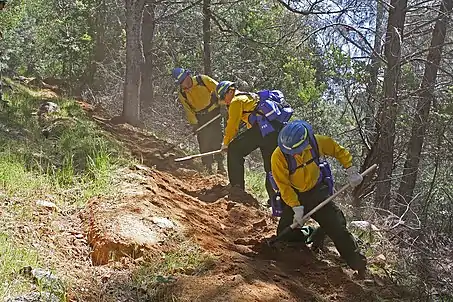California Conservation Corps
The California Conservation Corps, or the CCC, is a department of the government of California, falling under the state cabinet-level California Resources Agency. The CCC is a voluntary work development program specifically for men and women between the ages of 18 to 25 (up to 29 for veterans[1]), offering work in environmental conservation, fire protection, land maintenance, and emergency response to natural disasters. Members of the CCC are referred to as "Corpsmembers", and as of 2018, are paid a monthly stipend of $1,905.[2]

| CCC Conservation Corps | |
| Agency overview | |
|---|---|
| Formed | July 7, 1976 |
| Headquarters | 1719 24th Street, Sacramento, California |
| Employees | 1,500 - 2000 |
| Annual budget | $90.7 million (2016) |
| Agency executive |
|
| Parent agency | California Resources Agency |
| Website | http://www.ccc.ca.gov/ |
History
The bill to create the California Conservation Corps was co-authored by California State Senator Ruben Ayala.[3] The legislation was signed into law by Governor Jerry Brown on July 7, 1976, modeling the corps after the federal Civilian Conservation Corps that started with Franklin D. Roosevelt and the New Deal in the 1930s. Brown envisioned a department marketed specifically to the state's young people as "a combination Jesuit seminary, Israeli kibbutz, and Marine Corps boot camp."[4] The CCC replaced the California Ecology Corps that was created by executive order of Governor Ronald Reagan in 1971 as an "alternative service" option for Conscientious Objectors during the Vietnam War.[5]
Following the end of his governorship, Brown's successor, Governor George Deukmejian, signed legislation to eliminate the CCC's sunset clause by making it a permanent department under the California Resources Agency in 1983.
The duties of operation falling to the CCC include trail maintenance, riparian zone restoration, tree planting and exotic plant species removal, construction, and emergency flood and wildfire response. Other organizations pay the CCC to do the work. Corps-members are offered the chance to complete their high school diploma through independent CCC schools and are trained in cooking, office work, chainsaw, and vehicle maintenance. The CCC also encourages corpsmembers to seek higher education or vocational training by offering scholarships.
Since 1992, the California Department of Finance has allotted less funding to the CCC, forcing the closure of numerous residential centers throughout the state.
The CCC has received presidential praise as well as numerous awards for its work.[6]
Related organizations
There are Fourteen local conservation corps groups in California[7] that are certified annually by the CCC to offer similar job training, education, and environmental projects in other areas of California.[8]
- Cesar Chavez Environmental Corps – Tehachapi, CA
- Civicorps – Oakland, CA
- Conservation Corps North Bay – San Rafael, CA
- Conservation Corps of Long Beach – Long Beach, CA
- Fresno Local Conservation Corps – Fresno, CA
- Greater Valley Conservation Corps – Stockton, CA
- Los Angeles Conservation Corps – Los Angeles, CA
- Orange County Conservation Corps – Anaheim, CA
- Sacramento Regional Conservation Corps – Sacramento, CA
- San Francisco Conservation Corps – San Francisco, CA
- San Jose Conservation Corps – San Jose, CA
- Sequoia Community Corps – Visalia, CA
- Urban Conservation Corps of the Inland Empire – San Bernardino, CA
- Urban Corps of San Diego County – San Diego, CA
Urban Corps of San Diego
The San Diego local corps was founded in 1989 with help from former Representative Lynn Schenk and then-Mayor Maureen O'Connor, with an initial budget of $125,000.[9] They engage in a variety of community service and conservation projects, including stadium cleanup,[10][11] trash pickup[12] and graffiti removal.[13] There are about 200 Corpsmembers employed at any given time.[14]
See also
- California Department of Forestry and Fire Protection
- California Conservation Corps Foundation
References
- "Veterans Programs". 2014.
- "Frequently Asked Questions". CCC. Retrieved 5 January 2020.
- Woo, Elaine (January 7, 2012). "Ruben S. Ayala dies at 89; known as a maverick state senator". Los Angeles Times.
- "CCC History". 2004. Archived from the original on 2008-07-06. Retrieved 2008-01-14.
- "Reagan Announces Creation Of California Ecology Corps". St. Petersburg Times. 28 April 2971. Retrieved 11 October 2013. Check date values in:
|date=(help) - "Awards & Accolades". At A Glance. CCC. Retrieved 11 October 2013.
- "Local Conservation Corps". ccc.ca.gov. October 30, 2019.
- "Local Conservation Corps". CALCC. Retrieved August 6, 2018.
- "Rising from the Trenches Part 2". San Diego Reader. Retrieved August 7, 2018.
- "Qualcomm Stadium's Recycling Program" (PDF). EPA Archive. Retrieved August 7, 2018.
- "Demonstrating Collective Impact" (PDF). Corps Network. Archived from the original (PDF) on August 7, 2018. Retrieved August 7, 2018.
- "Mayor Faulconer announces expansion of 'Clean SD' program". KUSI News. Retrieved August 7, 2018.
- "Pacific Beach Graffiti Clean Up set for April 29". SD Community Newspaper. Retrieved August 7, 2018.
- "Item 13 Supporting Documents" (PDF). CA State Treasurer's Office. Retrieved August 7, 2018.
External links
- California Conservation Corps Official Website
- CCC Facebook Page
- CCC Foundation Website
- The California Conservation Corps State Museum
- Joe Hawkins's CCC Page Recollections of a Placer Fire Center member c. 1980-81